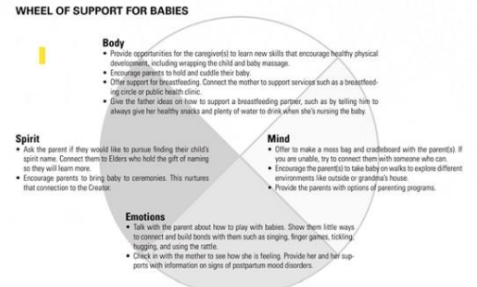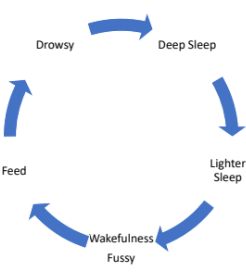Winter 25- INFANT - Student Copy2
NURS 2510 Client and Context 1: Human Growth and Development - Individual Development – The Infant
Course Objectives
At the end of the class, students will be able to:
Describe normal physical development, early motor skills, and perceptual abilities of infants.
Examine sleep and variations in infancy, emphasizing sleep stages and patterns.
Identify newborn reflexes and their purposes, such as the Moro and rooting reflexes.
Explore basic principles of cognitive development using Piaget's theory, including schema development and assimilation.
Examine language acquisition in infancy, covering milestones and parental interactions.
Describe the significance of attachment in human development, focusing on emotional security.
Differentiate between various attachment qualities, explaining secure versus insecure attachments.
Importance of Infant Development Knowledge for Nurses
Infants experience unparalleled growth in the first year, making it crucial for healthcare professionals to understand this phase. Knowledge of infant development helps nurses educate parents effectively about growth milestones and health promotion strategies.
Developmental Considerations – Nursing Assessment: Infants
Growth and Physical Development
Rapid Growth: Monitor weight, length, and head circumference to meet growth milestones, as these measurements indicate a healthy growth trajectory.
Reflexes: Assess primitive reflexes (such as the Moro, rooting, grasp, and Babinski), which are key indicators of neurological function and should typically diminish during infancy.
Motor Development: Evaluate gross motor skills (head control, rolling, sitting, and crawling) according to age benchmarks, while observing fine motor skills (grasping and reaching)
Cognitive & Sensory Development: Sensory Abilities: Infants rely heavily on sensory input; assess abilities such as tracking objects visually, responding to sounds, and recognizing familiar voices, as these are foundational to cognitive growth.
Psychosocial and Emotional Development: Observe caregiver-infant interactions to assess bonding and attachment
Stranger Anxiety: By about 6-8 months, infants may show fear of strangers. Use a calm gentle approach to reduce stress
Nutrition & Feeding: Assess breastfeeding, bottle-feeding, or solid food introduction (typically around 6 months)
Immunization & Health Screening: Vaccination Schedule: Ensure the infant is up-to-date on recommend vaccinations. Hearing & Vision: Early screening for hearing & vision is crucial for development
Developmental Milestones: Use tools such as the Denver Developmental Screening Test to evaluate milestones in gross motor, fine motor, language, & social skills
Pariental Education & Involvement: Involve parents in the assessment process & provide education on expected developmental milestones, safety, & health promotion
Infant Examination Considerations
Position - A parent should be presented to understand normal growth & development & for the child’s feeling of security. Place infant on the padded examination table & maintain a warm environment
If baby can sit w/out support, examination can be performed while baby is in the parent’s lap
By age 9 to 12 parents must be in full view of the infant as they become aware of their surroundings
Most infants like eye contact so lock the eyes with the baby from time to time., Smile and keep movements smooth not jerky
By the age of Two, toddlers start developing autonomy and become aware of the environment. A toddler should be sitting up in the parent’s lap for examination
Begin by greeting the child but focus more on the parent, this allows the child to see you from a safe distance. Do not offer choice – rather give firm instruction Or offer choices with limited option
Vital Signs for Infants and Young Children
Respirations:
Newborn to 1 month: 30-65 breaths/min
1 to 12 months: 26-60 breaths/min
1 to 10 years: 14-50
Blood Pressure:
Newborn to 6 months: Systolic 45-90, Diastolic 30-65
6 months to 2 years: Systolic 80-100, Diastolic 40-70
Children (2-13 years): Systolic 80-120, Diastolic 40-80
Heart Rate:
Newborn to 1 month: 100-175 BPM
1 month to 2 years: 90-160 BPM
Temperature: Normal range is 35.5-37.7°C; infants show sensitivity to temperature fluctuations → risk for hypo/hyperthermia
Auxillary temp tends to be one Celsius lower than oral
Rectal tends to be one Celsius higher than oral
Attachment Definition and Theory
Attachment: Refers to the emotional bond between an infant and their caregiver, which provides a sense of security and influences relationships throughout life.
Attachment Theory (Bowlby): View that the ability & need to form an attachment relationship early in life & genetic characteristics of all human beings
Proposes that by age 5, children create internal mental models of relationships, typically fostered by parenting behaviors
Majority of parents manage to respond to their infants in ways that foster the development of a close relationship
Stages of Attachment:
Pre-attachment: Birth to 6 Weeks; baby shows no particular attachment to specific caregiver
Indiscriminate: 6 Weeks to 7 Months; infant begins to show preference for primary & secondary caregivers
Discriminate: 7+ Months; infant shows strong attachment to one specific caregiver
Multiple: 10+ Months’ growing bonds w/ other caregivers
Attachment Behaviors and Types
Attachment Behaviors: These include stranger anxiety, separation anxiety, and social referencing, which reflect an infant's emotional state and adaptability.
social referencing - child uses the mother's emotions to express their emotions (child is sad b/c the mom is sad)
Types of Attachment:
Secure Attachment: The most common form; characterized by trust and comfort in the caregiver's presence.
Insecure Attachment: Can be categorized into avoidant (indifferent to their caregiver; will not go to parent to seek comfort), ambivalent(infant shows mixed reactions; want to be close contact w/ parents & hardly explored the world around them → parents are inconsistent), and disorganized/disoriented attachment styles(5-10%, least secure, when there is fear from the caregiver → linked to trauma & neglect), each affecting relational dynamics.
Five Factors Influencing Secure Attachment
Emotional Responsiveness: Caregivers consistently responding to an infant's needs fosters security.
Tactile Responsiveness: Physical affection promotes a sense of safety, comfort, & lessens stress.
Contingent Responsiveness: Caregiver's ability to respond to cues in a timely manner enhances attachment.
Marital Conflict and Mental Health: Parental mental health and the couple's relationship impact attachment quality (Children w/ both parents show secure attachment)
Characteristics of Securely Attached Children
Typically sociable and exhibit positive behavior towards peers and siblings, along with emotional maturity and empathy. Less likely to display clinginess or aggression.
Impact of Loss of Attachment
Loss of attachment can have broader implications for well-being, particularly for children separated from families due to circumstances like immigration, historical events, or conflict situations.
Around the World - the USA where children are being taken from their families when they cross broader, war ravaged countries
In the Past - During the Good Food shortage — orphans were sent to Canada, USA, & Australia
Large-scale prevention measures are required such as truth & reconciliation commission (recognizing harms that are done in the past), better immigration policies
May lead to inter-generational trauma
Nurse Contribution: learning about troubled communities, teaching (new) parents
Indigenous Teachings on Babies
Emphasis on joy, love, bonding, and healthy development, with a focus on trust and support for new parents.
Strategies for Supporting Baby Development
Body: Encourage caregiver skill development, such as techniques for massage and holding.
Spirit and Mind: Facilitate connections with Elders for cultural guidance and encourage infants’ exploration of environments.
Emotions: Promote interactive play, recognize maternal health impacts, and provide resources related to postpartum mood disorders

Decolonizing & Resiliency:
Prenatal Teaching
Midwaives
Ancestral teachings & ceremonial practices
Naming ceremonies
Walking out ceremonies
E.g. Moss bag, baby swing, cradle board (tikanakan)
Health Promotion Strategies
Immunizations: Vital for preventing infectious diseases.
Supporting Breastfeeding:
Address environmental factors like secondhand smoke and promoting safe sleep practices
Can result in infant death
Sleep – States of Consciousness
Sleep cycles typically repeat every 2 hours in infancy, with routines developing around 6 months due to circadian rhythm maturation. Cultural beliefs also influence parental responses to sleep patterns
by 8 weeks, some develop day/night routine & can sleep up to 2-3 hours
6 months - babies sleep about 13 hours & have defined sleep routines
Cultural beliefs can play a role related to parent’s responses to sleep patterns
Central sleep apnea, obstructive sleep apnea (some obstruction in airway)

Colic
Generally presents from 2-3 weeks of age, resolving by 3-4 months; reassurance for parents is essential as it is usually self-limiting and non-pathological w/ no long-term effects
Cause: gut inflmmmaiton, inflamed gut microbes (non breastfed)
Sudden Infant Death Syndrome (SIDS)
Recommendations for safe sleeping include placing infants on their backs, avoiding soft bedding, room-sharing for at least the first 6 months, and maintaining smoke-free environments to reduce risks
Sudden & unexpected death of an apparently healthy infant under 1 year
Parents & caregivers are encouraged to provide a safe sleep environment which includes:
Placing baby on their backs (evidence-based)
Eliminating quilts, duvets, pillows, soft toys, crib bumpers
Only a fitted sheet is recommended
Avoiding laying the baby on a soft surface
Having the baby sleep in a crib or cot near the parent’s bed for the first six months
Avoiding bedsharing or otherwise sleeping w/ the baby on a sofa especially if parents smoke, are more tired than usual, &/or have consumed alcohol or other substances that promote fatigue
Providing a smoke free environment during pregnancy & post birth
Sexuality Considerations
Factors influencing sexual well-being include physiological (child is suffering from visual impairment, etc), psychological (any adverse or traumatic experiences), and environmental(may be positibe in tmer so relationsips), maturational (allows to make bond w/ the caregivers) aspects; family attitudes play a significant role in development throughout childhood
Key Takeaways
Understanding normal and abnormal development through attachment, health promotion, and focusing on infant sleep, feeding, and overall wellness is essential for effective nursing practice.
Practice Questions
What are the potential benefits & challenges of having standardized development milestones of infancy?
Allows parents to understand & know the milestones that the child is "supposed” to hit during that age
Differentiate abnormal & normal diagnosis
Challenge:
Child may not have reached milestone not because of a medical issue but is dependent on their environment, how theyre being raised
EXAM:2 study-based questions